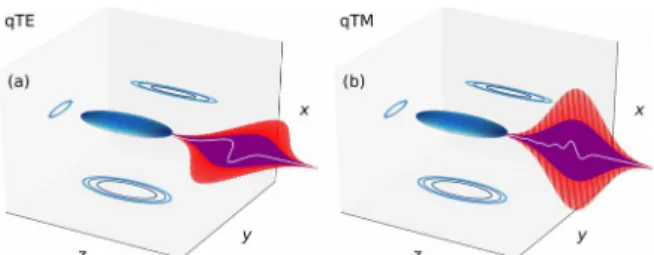HAL Id: hal-01924407
https://hal.archives-ouvertes.fr/hal-01924407
Submitted on 15 Nov 2018HAL is a multi-disciplinary open access
archive for the deposit and dissemination of sci-entific research documents, whether they are pub-lished or not. The documents may come from teaching and research institutions in France or abroad, or from public or private research centers.
L’archive ouverte pluridisciplinaire HAL, est destinée au dépôt et à la diffusion de documents scientifiques de niveau recherche, publiés ou non, émanant des établissements d’enseignement et de recherche français ou étrangers, des laboratoires publics ou privés.
Resonant Effects in Terahertz Generation with
Laser-Induced Gas Plasmas
I. Thiele, B. Zhou, A. Nguyen, E. Smetanina, R. Nuter, P. González de Alaiza
Martínez, K Kaltenecker, J. Déchard, L. Berge, P Jepsen, et al.
To cite this version:
I. Thiele, B. Zhou, A. Nguyen, E. Smetanina, R. Nuter, et al.. Resonant Effects in Terahertz Gen-eration with Laser-Induced Gas Plasmas. TERA - 2018 3rd International Conference Terahertz and Microwave Radiation: Generation, Detection and Applications, Oct 2018, Nizhny Novgorod, Russia. pp.03011, �10.1051/epjconf/201819503011�. �hal-01924407�
Resonant Effects in Terahertz Generation with Laser-Induced Gas Plasmas
I. Thiele
1,2, B. Zhou
3, A. Nguyen
4, E. Smetanina
1,5, R. Nuter
1, P. González de Alaiza
Martínez
1, K. J. Kaltenecker
3, J. Déchard
4, L. Bergé
4, P. U. Jepsen
3, and S. Skupin
1,61Univ. Bordeaux - CNRS - CEA, Centre Lasers Intenses et Applications, Talence, France 2Department of Physics, Chalmers University of Technology, Göteborg, Sweden
3DTU Fotonik, Technical University of Denmark, Kongens Lyngby, Denmark 4CEA/DAM Ile-de-France, Bruyères-le-Châtel, 91297 Arpajon, France
5Department of Physics, University of Gothenburg, Göteborg, Sweden
6Institut Lumière Matière, Université Lyon 1 - CNRS, Villeurbanne, France, stefan.skupin@univ-lyon1.fr
Research on intense terahertz (THz) electromag-netic sources has received an increasing attention ow-ing to numerous applications, for example, in time-domain spectroscopy, biomedical imaging or security screening [1]. Among the various techniques em-ployed to generate THz radiation, focusing intense two-color femtosecond pulses in air or noble gases provides interesting features like absence of material damage, large generated bandwidth (up to ~100 THz) and high amplitudes of the emitted THz pulses (> 100 MV/m) [2]. First reported by Cook et al. [3], THz emission from intense two-color pulses was initially attributed to optical rectification via third-order non-linearity. However, it was shown later that the plasma built-up by tunneling photoionization is necessary to explain the high amplitudes of the THz field [4], and a quasi-dc plasma current generated by the temporally asymmetric two-color field is responsible for THz emission [5].
Numerous experimental results show that the laser-induced free electron density has a strong impact on the THz emission [4,6,7]. While it is frequently observed that a larger free electron density leads to broader THz spectra, the origin of the effect remains controversial. In [6,7], homogeneous plasma oscilla-tions were proposed as an explanation, even though those oscillations are in principle non-radiative [8,9]. Moreover, nonlinear propagation effects have been held responsible for THz spectral broadening as well [10]
On the other hand, the gas plasma produced by the fs laser pulse is a finite conducting structure with a lifetime largely exceeding the fs time scale. Thus, one can expect that the gas plasma features plasmonic resonances which may have a strong impact on the THz emission propertie [11]. However, no direct evi-dence of plasmonic effects in laser-induced gas-plas-mas was observed so far: To make an evidence of plasmonic effects, those need to be distinguished from nonlinear propagation effects. Also from the theoreti-cal point of view capturing plasmonic effects is not trivial: plasmonic effects require at least a full two-di-mensional Maxwell-consistent description, and re-duced models like the unidirectional pulse propaga-tion equapropaga-tion [12], which are frequently used to de-scribe plasma-based THz generation [5,7,10], are by construction not capable of capturing such resonant effects.
In this work, we consider the two-color-laser-in-duced plasma as a plasmonic structure, and
investi-gate under which conditions such plasmonic perspec-tive is important. In the context of plasmonic nanoan-tennas (or metamaterials), e.g, for second-harmonic generation, tailoring plasmonic resonances by tuning the shape of the plasmonic particle is a standard ap-proach. Therefore, we follow a similar strategy and modify the usually prolate spheroidal plasma shape. Going to tri-axial ellipsiods which can be achieved by using elliptically shaped laser beams turns out to be already sufficient [13]. Depending on whether the laser polarization is oriented along the long beam axis (quasi transverse electric, qTE) or along the short beam axis (quasi transverse magnetic, qTM), plas-monic resonances are triggered or not (see Fig. 1).
Fig. 1. Illustrated configurations of THz emission from an ellipsoidal plasma induced by a two-color Gaussian laser pulse~(funamental in red, second-harmonic in purple) with strongly elliptical beam shape propagating along z. The laser electric field is y-polarized (along the long axis of the beam, qTE) in (a) and x-polarized (along the short axis, qTM) in (b). The plasma is sketched as blue surface. Simu-lated forward emitted THz pulses are presented as white lines demonstrating a significantly shorter pulse duration for qTM polarization, which can be attributed to triggering a plasmonic resonance.
While nonlinear propagation effects are in both cases equally present, any difference between the THz emission spectra in this two cases is linked to plas-monic effects. We demonstrate experimental results which reveal a significant difference: THz pulses are shorter and have a broader emission spectrum when the plasma is excited by the laser field in the direction with the short focal beam width and plasma width (see Fig. 2). A simple analytical model allows us to link the broadening to a leaky mode. It turns out that the resonance has a strong impact on the spectrum whenever electrons are excited along a direction where the plasma size is smaller than the plasma wavelength. Finally, direct three-dimensional (3D) Maxwell consistent simulations in tightly focused ge-ometry confirm that these plasmonic resonances in-deed broaden the emitted THz spectrum significantly.
Fig. 2. Experimental THz spectra for qTE (a) and qTM (b) polarization (see text for details). Corresponding on-axis THz waveforms are shown as insets. The dashed lines spec-ify the estimated maximum plasma frequency.
References
[1] M. Tonouchi. Cutting-edge terahertz technology. Nature Photon., 1:97, 2007.
[2] K. Kim et al. High-Power Broad¬band Terahertz Generation via Two-Color Photo-ionization in Gases. IEEE J. Quant. Electron., 48:797, 2012.
[3] D. Cook et al. Intense terahertz pulses by four-wave rectification in air. Opt. Lett., 25:1210, 2000.
[4] K. Kim et al. Coherent control of terahertz supercontinuum generation in ultrafast laser-gas interactions. Nature Photon., 2:605, 2008.
[5] L. Bergé et al. 3D numerical simulations of THz generation by two-color laser filaments. Phys. Rev. Lett., 110:073901, 2013.
[6] H. Hamster et al. “Short-pulse terahertz radiation from high-intensity-laser-produced plasmas,” Phys. Rev. E, 49:671, 1994.
[7] V. A. Andreeva et al. Ultrabroad terahertz spectrum generation from an air-based filament plasma,” Phys. Rev. Lett., 116:063902, 2016.
[8] V. T. Tikhonchuk, Comment on “generation of electromag-netic pulses from plasma channels induced by femtosecond light strings”, Phys. Rev. Lett., 89:209301, 2002.
[9] I. Thiele et al. Theory of terahertz emission from femtosecond-laser-induced microplasmas, Phys. Rev. E, 94:063202, 2016.
[10] E. Cabrera-Granado et al. “Spectral self-action of thz emission from ionizing two-color laser pulses in gases, New J. Phys., 17:023060, 2015.
[11] V. A. Kostin at al. Dc to ac field conversion due to leaky-wave excitation in a plasma slab behind an ionization front, New J. Phys., 17:033029, 2015.
[12] M. Kolesik at al., Nonlinear optical pulse propagation simulation: From Maxwell’s to unidirectional equations, Phys. Rev. E, 70:036604, 2004.
[13] I. Thiele et al. Terahertz emission from laser-driven gas-plasmas: a plasmonic point of view. arXiv:1803.06889 [physics.optics], 2018.

